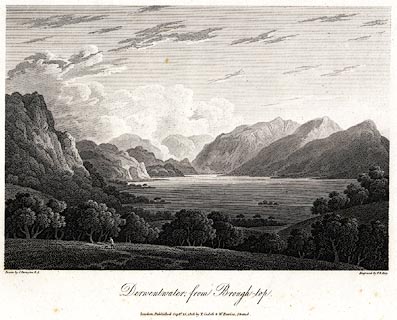

private collection (114)
image:-
© see bottom of page

click to enlarge
Plate 17 in The Lakes of Lancashire, Westmorland, and Cumberland.
The accompanying text is by Thomas Hartwell Horne:-
DERWENTWATER FROM BROUGH TOP.
DERWENT-WATER, or KESWICK LAKE, as it is frequently termed from its vicinity to the town of Keswick, is of an irregular form, somewhat approaching to the oval, and about three miles in length, by one and a half in width. By many tourists, this Lake has been supposed to be the finest in the North of England; but for grandeur and sublimity Ulswater is now allowed to claim the pre-eminence. Derwentwater, however, has this decided advantage over the other Lakes, viz. that it immediately appears to be what it is. The dark frowning Skiddaw 'forms its northern boundary, and seems to rise almost immediately from its shore, though it is at its nearest point half a league distant, and the town of Keswick intervenes. One long mountain, along which the road forms a fine terrace, reaches nearly along the whole of its western side: and through the space between this and the next mountain, which in many points of view appears like the lower segment of a prodigious circle, a lovely vale is seen which runs up amomg the hills.' But the pride of Derwentwater is the head, where the mountains of Borrowdale bound the prospect in a manner singularly wild and grand. Our view, which is taken from Brough Top (an eminence on the left of the road to Keswick from Ambleside,) will convey an accurate idea of its general features. 'The whole,' says Mrs. Radcliffe, 'is seen at one glance, expanding within an amphitheatre of mountains, rocky but not vast; broken into many fantastic shapes, peaked, splintered, impending, and sometimes pyramidal, opening by narrow vallies to the view of rocks that rise immediately byeond (sic), and are again overlooked by others. The precipices seldom hang over the water, but are arranged at some distance; and the shores swell with woody eminences, or sink into green pastural margins. Masses of wood also appear among the cliffs feathering them to their summits' (as may be seen in the foreground on the left of our engraving;) 'and a white cottage sometimes peeps from out their skirts, seated on the smooth knoll of a pasture, and looking so exquisitely picturesque, as to seem placed there purposely to adorn it. The Lake in return faithfully reflects the whole picture; and so even and brilliantly pellucid is its surface, that it rather heightens than obscures the colouring.'
Drawn by J. Farington. / Engraved by F. R. Hay. / Derwentwater from Brough-top. / London, Published Septr. 15, 1815, by T. Cadell & W. Davies, Strand.
 Derwentwater from Brough Top
Derwentwater from Brough Top